Whilst there is nothing more satisfying than going out for an early morning run or walk or finishing off the day with either, we can suffer from various niggles that prevent us from enjoying ourselves, cause us pain and hence force us to stop.
This article will explain common injuries sustained by walkers and runners that can be easily managed and prevented with specific physiotherapy manual treatment, prescribed strengthening exercises and clinical pilates.

1. KNEE PAIN: Patellofemoral joint pain (PFJ)
PFJ is pain experienced in the front of your knee or behind your knee cap , where your patella (knee cap) meets your femur (thigh bone), mainly caused by excessive pressure through the knee joint or poor knee tracking during repeated weight bearing exercises, such as running and walking.
Poor biomechanical control when bending the knees as well as various weak muscles could be the contributing factors as to why someone may be suffering from PFJ.
Simple strengthening exercises, soft tissue release through tight/sore muscles and correction of foot posture can alleviate the symptoms of PFJ and get you back to running/walking pain-free!
2. SHIN SPLINTS: (Medial tibial stress syndrome)
Shin splints is an overuse injury caused by repetitive strain on your shin. The pain is caused by stress reactions of the tibia (bone) and muscles around it.
The pain will most often be felt down the bottom of the shin during the weight bearing phase of running or walking, or repetitive jumping activities. The pain can be caused by a sudden increase in load, altered foot mechanics- e.g. poor foot posture/control, new footwear, exercising on different surfaces or calf weakness.
Manual therapy such as massage, proper assessment of gait and foot position in landing combined with rest can alleviate symptoms and prevent it from occurring again.
3. PLANTAR FASCITIS
Plantar fasciitis is a pain on the bottom of your foot, normally experienced after exercise- not during it. Our plantar fascia acts as a shock absorber normally, lining the bottom surface of our foot, however in some instances micro-tears, inflammation and irritation can arise from repetitive stretching or increased tension.
Poor foot mechanics, repetitive load, poor footwear (especially flat) and certain types of exercise can all aggravate our plantar fascia and thus cause pain.
Assessment of foot mechanics and footwear, strengthening, taping, orthotics and manual therapy from your physio can all assist with the diagnosis and management.
4. ACHILLIES TENDINOPATHY
Pain experienced at the back of the heel is likely an achillies tendinopathy. It is pain caused by repetitive trauma in between which the tendon has no time to heal properly. Micro tears and collagen damage to the tendon are the main source of pain. Similar to plantar fasciitis, poor footwear, repetitive running (especially long distance), poor running technique, training surface and muscular weakness (calves especially) can be contributing factors.
Pain is normally worse after exercise is completed, and is especially stiff when a person first wakes in the morning. It is commonly very tender around the affected area and whilst runners may notice it at the commencement of a run, it normally feels better or “warms up” during and then pain occurs again once the run is complete.
Stretching, targeted strengthening, rest, ice, manual therapy from your physio and possible orthotics can ease the associated symptoms of an achillies tendinopathy.
5. HIP PAIN (GLUTE MED TENDINOPATHY/TENDON PAIN)
Pain at or around the hip joint in the glute area during running or walking is normally a tendinopathy of the gluteus medius tendon (basically- a tendon that is aggravated by repetitive load and use). The pain is normally when you are using the tendon such as walking, running, jumping, normally very stiff especially in the morning and you may even feel or hear a “click” or “crunching” sound when the tendon is being stretched or used.
General wear and tear as we age or over using the muscle/tendon can stress the tendon, and although tendons are built to withstand high loads, occasionally the load becomes too much and the tendon can becomes damaged.
Rest, ice, biomechanical assessments, targeted strengthening, clinical pilates and soft tissue release from your physio can improve hip pain and get someone back to pain-free walking or running.
If you are experiencing one or more of these listed pains or conditions we strongly encourage you to be proactive and seek treatment not only to alleviate symptoms but also improve your overall running and walking, meaning you can perform better-for longer!
I have been involved with long distance running since as long as I can remember, and having experienced one, if not all of these niggles at some stage I cannot stress enough the importance of fixing them- not only are they annoying but they really hurt! My running has benefited greatly and my body has definitely thanked me for it!
Freya graduated with a Bachelor of Health Sciences and a Masters of Physiotherapy practice degree from La Trobe University. She has completed various clinical Pilates courses and has a keen interest in sporting injuries and rehabilitation, in particular return to running. Freya is also the physio for an under 18-rugby team and is in the process of undertaking further education to enhance her musculoskeletal and sports physiotherapy practice.
